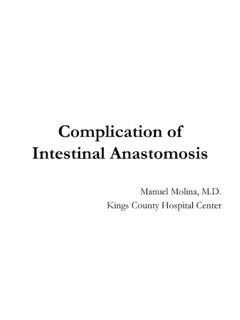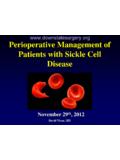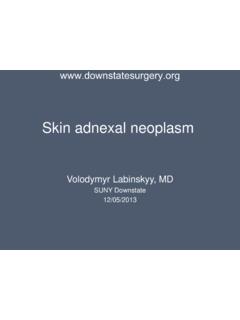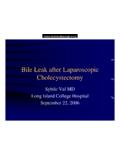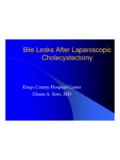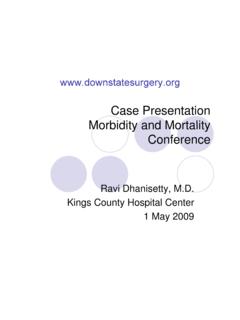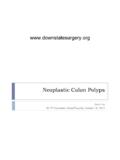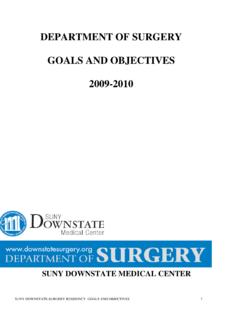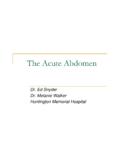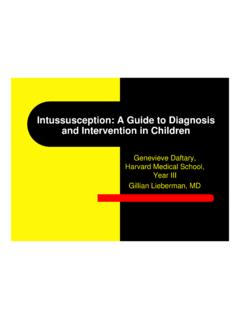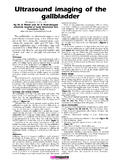Transcription of Management of Pyogenic Liver Abscess
1 Management of Pyogenic Liver AbscessManagement of Pyogenic Liver AbscessAparna Kolli County Hospital CenterJuly 2006 Aparna Kolli County Hospital CenterJuly 2006 HPIHPI xx yo male inpatient in the Psychiatric ward complaining of fever, right sided abdominal pain and discharge from his umbilicus Denied any N/V/D or chills NKDA PMHx: schizophrenia, DM, obesity PSxHx: denies SocHx: negative xx yo male inpatient in the Psychiatric ward complaining of fever, right sided abdominal pain and discharge from his umbilicus Denied any N/V/D or chills NKDA PMHx: schizophrenia, DM, obesity PSxHx: denies SocHx: negativePhysical ExamPhysical Exam General: NAD, lying in bed CVS: tachycardic Chest: bibasilar decreased breath sounds Abd: obese, soft, mildly distended, RUQ tenderness on palpation, +voluntary guarding, no rebound, +purulent discharge from umbilicus Ext: +pedal edema General: NAD, lying in bed CVS: tachycardic Chest: bibasilar decreased breath sounds Abd: obese, soft, mildly distended, RUQ tenderness on palpation, +voluntary guarding, no rebound, +purulent discharge from umbilicus Ext: +pedal edemaVitals and Laboratory ValuesVitals and Laboratory Values Tm: BP: 154/87 HR: 105 Tm: BP: 154/87 HR: 105 WBC: ; PMN: 48% H/H: Lactate: AlkPhos: 192 AST/ALT: 57/70 Tbili: PT/PTT/INR: WBC.
2 PMN: 48% H/H: Lactate: AlkPhos: 192 AST/ALT: 57/70 Tbili: PT/PTT/INR: CourseHospital Course Patient emergently transferred to the SICU CT Abd/Pelvis performed Multiple intraabdominal abscesses and significant amount of free air Resuscitated and emergently taken to OR Patient emergently transferred to the SICU CT Abd/Pelvis performed Multiple intraabdominal abscesses and significant amount of free air Resuscitated and emergently taken to ORImaging StudiesImaging StudiesImaging StudiesImaging StudiesImaging StudiesImaging StudiesOR CourseOR Course Significant intraabdominal pus Dense adhesions Sealed off perforation at appendix tip Large friable Abscess on superior right Liver lobe Abscess deroofed with drainage of >1liter of pus Abdomen irrigated 2 sump drains and a JP left in place Significant intraabdominal pus Dense adhesions Sealed off perforation at
3 Appendix tip Large friable Abscess on superior right Liver lobe Abscess deroofed with drainage of >1liter of pus Abdomen irrigated 2 sump drains and a JP left in placeManagement of Pyogenic Liver AbscessManagement of Pyogenic Liver AbscessHistorical PerspectiveHistorical Perspective First comprehensive study was done by Ochsner and DeBakey in 1938 Historically Liver abscesses developed in young, healthy patients with an intraabdominal infection, most likely secondary to acute appendicitis Demographics have changed significantly over past four decades with the improvement in operative techniques and advent of antibiotics First comprehensive study was done by Ochsner and DeBakey in 1938 Historically Liver abscesses developed in young, healthy patients with an intraabdominal infection, most likely secondary to acute appendicitis Demographics have changed significantly over past four decades with the improvement in operative techniques and advent of antibioticsEpidemiologyEpidemiology Overall incidence increased from 13/100,000 to 20/100,000 hospital admissions over twenty year period Overall incidence increased from 13/100,000 to 20/100,000 hospital admissions over twenty year period Huang et al.
4 , Pyogenic Hepatic Abscess : Changing Trends Over 42 Years, Annals of Surgery, 1996; 5:600-609 Pathogenesis of the diseasePathogenesis of the disease Liver regularly exposed to bacteria via portal circulation Routine clearance occurs without incidence Abscess occurs when the inoculum of bacteria exceeds the Liver s ability to clear the bacteria Liver regularly exposed to bacteria via portal circulation Routine clearance occurs without incidence Abscess occurs when the inoculum of bacteria exceeds the Liver s ability to clear the bacteriaPathogenesis of the diseasePathogenesis of the disease Routes of Infection Via biliary tree Via portal vein Via hepatic artery Direct extension from a nearby focus of infection Blunt or penetrating trauma Obscure origin Routes of Infection Via biliary tree Via portal vein Via hepatic artery Direct extension from a nearby focus of infection Blunt
5 Or penetrating trauma Obscure originHuang et al., Pyogenic Hepatic Abscess : Changing Trends Over 42 Years, Annals of Surgery, 1996; 5:600-609 Pathogenesis of the diseasePathogenesis of the disease Routes of Infection Via biliary tree Routes of Infection Via biliary treeHuang et al., Pyogenic Hepatic Abscess : Changing Trends Over 42 Years, Annals of Surgery, 1996; 5:600-609 Pathogenesis of the diseasePathogenesis of the disease Routes of Infection Via biliary tree Via portal vein Routes of Infection Via biliary tree Via portal veinHuang et al., Pyogenic Hepatic Abscess : Changing Trends Over 42 Years, Annals of Surgery, 1996; 5:600-609 Pathogenesis of the diseasePathogenesis of the disease Routes of Infection Via biliary tree Via portal vein Via hepatic artery Routes of Infection Via biliary tree Via portal vein Via hepatic arteryHuang et al.
6 , Pyogenic Hepatic Abscess : Changing Trends Over 42 Years, Annals of Surgery, 1996; 5:600-609 Pathogenesis of the diseasePathogenesis of the disease Routes of Infection Via biliary tree Via portal vein Via hepatic artery Direct extension from a nearby focus of infection Routes of Infection Via biliary tree Via portal vein Via hepatic artery Direct extension from a nearby focus of infectionHuang et al., Pyogenic Hepatic Abscess : Changing Trends Over 42 Years, Annals of Surgery, 1996; 5:600-609 Pathogenesis of the diseasePathogenesis of the disease Routes of Infection Via biliary tree Via portal vein Via hepatic artery Direct extension from a nearby focus of infection Blunt or penetrating trauma Routes of Infection Via biliary tree Via portal vein Via hepatic artery Direct extension from a nearby focus of infection Blunt or penetrating traumaHuang et al.
7 , Pyogenic Hepatic Abscess : Changing Trends Over 42 Years, Annals of Surgery, 1996; 5:600-609 Pathogenesis of the diseasePathogenesis of the disease Routes of Infection Via biliary tree Via portal vein Via hepatic artery Direct extension from a nearby focus of infection Blunt or penetrating trauma Obscure origin Routes of Infection Via biliary tree Via portal vein Via hepatic artery Direct extension from a nearby focus of infection Blunt or penetrating trauma Obscure originHuang et al., Pyogenic Hepatic Abscess : Changing Trends Over 42 Years, Annals of Surgery, 1996; 5:600-609 Underlying EtiologyUnderlying Etiology Biliary pathology Hepatic cirrhosis Hepatocellular carcinoma Ruptured appendicitis Colon diverticulitis Ampullary carcinoma Metastatic Liver tumors Biliary pathology Hepatic cirrhosis Hepatocellular carcinoma Ruptured appendicitis Colon diverticulitis Ampullary carcinoma Metastatic Liver tumors et al.
8 , Pyogenic Liver Abscess : A Retrospective Analysis of 107 Patients During a 3-Year Period, Japanese Journal of Infectious Disease, 2005; 58: 366-368 Characteristics of InfectionCharacteristics of Infection Right lobe involvement 75% Left lobe involvement 20% Caudate lobe involvement 5% Bilobar involvement uncommon Solitary Abscess 50% Size of Abscess varies from <1mm to several cm May be loculated or occur as a single cavity Right lobe involvement 75% Left lobe involvement 20% Caudate lobe involvement 5% Bilobar involvement uncommon Solitary Abscess 50% Size of Abscess varies from <1mm to several cm May be loculated or occur as a single cavityCharacteristics of InfectionCharacteristics of Infection Gross appearance: Tan, fluctuant structure May cause local adhesion secondary to inflammation Gross appearance.
9 Tan, fluctuant structure May cause local adhesion secondary to inflammationMicrobiologyMicrobiology Microbiology of Abscess reflects source Abscesses due to pyelophlebitis or cholangitis tend to be polymicrobial 40% are polymicrobial Majority are solitary Isolated organisms include: Enterococci and streptococci Abscesses due to systemic infection tend to be monomicrobial Most commonly staphylococcal species Microbiology of Abscess reflects source Abscesses due to pyelophlebitis or cholangitis tend to be polymicrobial 40% are polymicrobial Majority are solitary Isolated organisms include: Enterococci and streptococci Abscesses due to systemic infection tend to be monomicrobial Most commonly staphylococcal species Microbiology of InfectionMicrobiology of Infection Most common organisms cultured are: Klebsiella pneumonia and E.
10 Coli Other organisms include: Staphylococcus aureus, enterococcus, streptococcus viridans and bacteroides species Uncommon organisms encountered: pseudomonas, proteus, enterobacter, citrobacter, serratia, -hemolytic strep, microaerophilic strep, fusobacterium, clostridium and other rare anaerobes Fungal and mycobacterial hepatic abscesses are rare and are associated with immunosuppression Most common organisms cultured are: Klebsiella pneumonia and E. coli Other organisms include: Staphylococcus aureus, enterococcus, streptococcus viridans and bacteroides species Uncommon organisms encountered: pseudomonas, proteus, enterobacter, citrobacter, serratia, -hemolytic strep, microaerophilic strep, fusobacterium, clostridium and other rare anaerobes Fungal and mycobacterial hepatic abscesses are rare and are associated with immunosuppressionLee et al.

